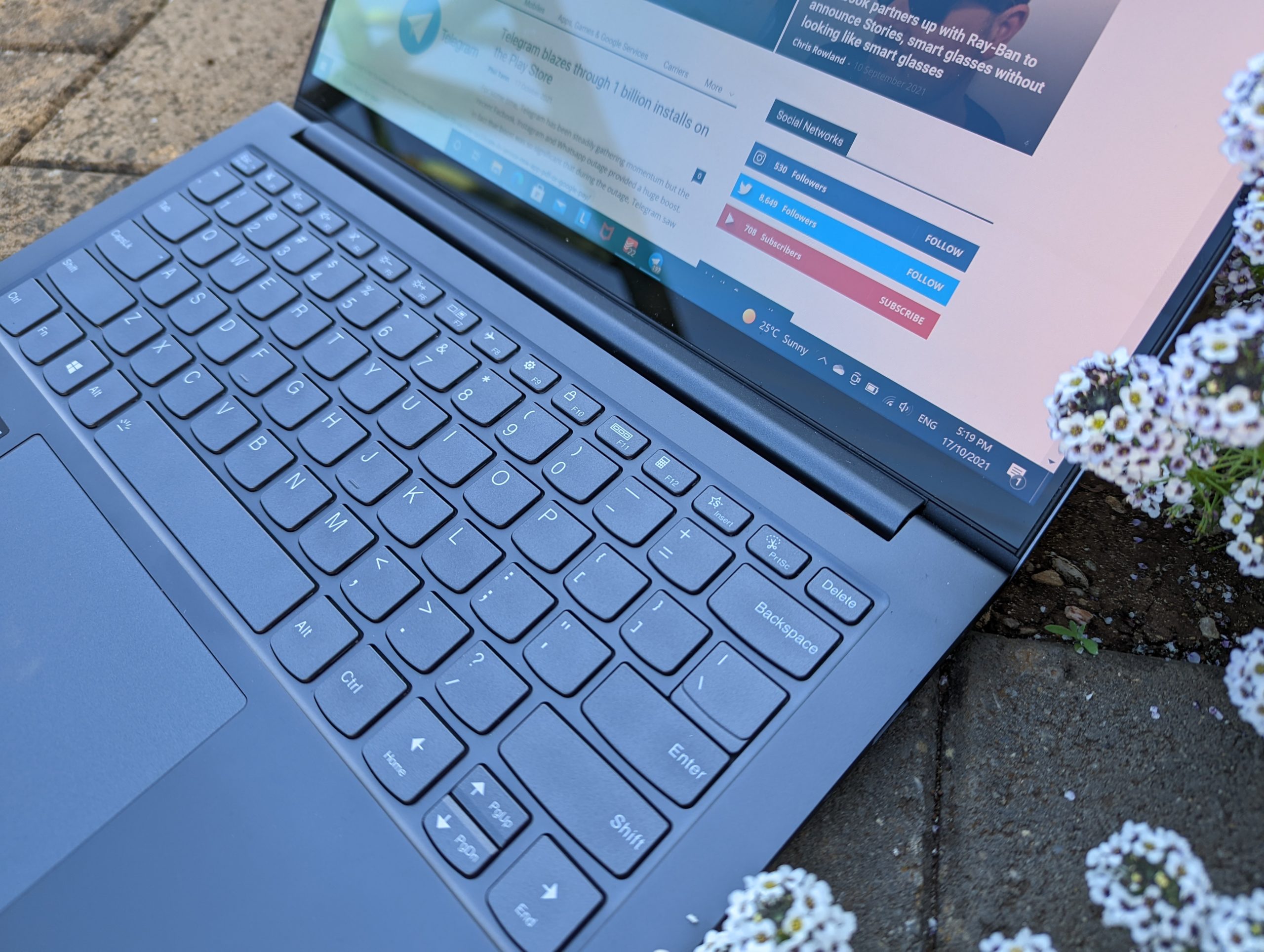Over the past 18 months or so, we’ve had hands-on with a number of laptops of varying ranges. Everything from very functional workhorse laptops through to an absolute beast that ticks every box, except being budget-friendly.
On the test bench over the last couple of weeks we’ve had the Lenovo YOGA Slim 7 Pro (Ryzen), which is very, very impressive. This is a device positioned to take on laptops like Huawei’s Matebook X Pro, Apple’s Macbook Pro and Surface laptops. So unsurprisingly, it is not going to be a cheap option it’s a powerhouse and it’s an investment.
What is it?
Clearly, it’s a laptop but there’s a lot more to it than you see on the surface. When you look at the specs of the YOGA Slim 7 Pro you’re looking at some very sharp specs. It’s been designed to be slim, lightweight, aesthetically pleasing and to meet all the performance needs of the user.
Internally there are some pretty sharp specs with a couple of SKUs available:
- Processor: AMD Ryzen 7 5800H
- Graphics: ATI Radeon
- Memory: 16 GB DDR4-3200
- Screen: 14” 2880 x 1800 pixel 90Hz refresh at 243 PPI
- Storage: 1TB M.2 NVMe SSD
- Weight: 1.32 kilograms
Design and features
It’s a really stylish looking laptop, with some great design elements and well thought out hardware features. The basic interface with the laptop is, of course, the keyboard which has a really nice, somewhat soft touch to it being a chiclet keyset. Unlike other laptops we’ve had recent experience with, the power button isn’t in the way when typing as it’s built into the right side of the device.
The keyboard also has a really slick look to it, it’s got standard-sized keys although — it’s too small — not a full-sized keyboard. The keys are backlit and that makes it easy to see in varied lighting conditions.
When it comes to the looks of the laptop there are a couple of things that are pretty striking. The 14” screen has a narrow bezel, interestingly it’s not a touch screen which seems to be the norm in higher-end laptops. The fact that this is high res, high refresh and decent PPI makes the screen very easy on the eyes producing dynamic lighting to your surroundings, as well as vibrant colours for daily productivity and entertainment.
If you’ve got a great laptop and terrible connectivity, you’ve got a terrible experience. In this instance, there’s a fine balance that needs to be met between meeting users needs with older peripherals and modernising the system.
Sporting Wi-Fi 6 there’s an element of future-proofing right from the get-go. There are a couple of USB-C (1 x Thunderbolt which includes charging) ports on the left side, with a USB-A port on the right, between the headphone port and power button. The USB-C charging is really welcome because it’s a standard connection, many chargers will work effectively (although some charge slowly) which also means you don’t have to carry a huge charging brick.
Daily performance and gaming
The specs are clearly very good, while many will argue that AMD “isn’t as good” or “is just a cheaper option” those are statements that are about 15 years out of date. These days, in terms of performance you’ll still see a big bang for buck offering, but the majority of users (aside from those needing specific Intel/Nvidia compatibility) won’t notice the difference. That’s certainly the case here whether it was daily use to a bit of playing around with video, the Yoga coped well.
This really is a laptop that’s designed to work for you and last. While I didn’t expect it to, the Yoga also managed some gaming with recent(ish…) releases — Including Call of Duty, Portal, F1 2020 and Diablo II — causing no real drama for it. There were some moments of frameskip and lag in the really heavy graphic processing moments, but in fairness, this isn’t a purpose gaming laptop and that’s to be expected.
The battery life is an absolute highlight for me with near a full day of general productivity work — with the performance settings wound down one click — on a single charge. This of course is relatively low processor intensity and the screen being adjusted down to suit lighting.
Of course, if you’re gaming or doing other processor and/or graphic intensive tasks that battery life will be significantly lower. But with a suitably capable portable battery pack, it would be feasible to do a day trip or overnight and not need to carry the charging brick to recharge your 61Wh battery.
The good and the bad…
The Slim 7 Pro has a lot going for it starting with the somewhat understated looks and great design. But that allure will only capture a small percentage of users, you need the performance to back it up. The only time I really noticed any issues with performance was running relatively high-end games which pushed the GPU beyond its capacity – not something that I actually have a problem with given this isn’t a purpose-built gaming machine.
Probably the biggest highlight for me on this machine is the screen. While 90Hz isn’t exactly earth-shattering, it’s quite lovely when your daily use laptop runs nowhere near that level. It also makes video playback significantly smoother and more pleasurable to watch.
The biggest barrier I can see to this being an exceedingly popular laptop is the price. It’s expected (available from November) to sell in Australia for $2,149.00 for the base model and going up from there. While that in itself is around the mark for a device with sharp end specs, if you’re looking for a workhorse and don’t need the video power: There are plenty of very capable options for a significantly lower price. In my experience and in discussion with those still in the retail game, $2,000.00+ laptops are a rarity to sell and a $200 – $300 price drop would make these a lot more salable to the general market.
Personally, I tend to use a headset when I’m listening to music, so it wasn’t a huge factor for me in gaming or music playback but I did find the audio a bit tinny. It wasn’t horrible but it was noticeably out of balance for what I would expect of a machine of this calibre. In daily use though, if you’re playing music quietly or on video calls you’re unlikely to notice any issues.
Should you buy one?
It’s a great laptop, it performs well and is even capable of delivering a pretty good gaming experience. So if you’re in the market for a new, high-end laptop yes this should probably figure on your shopping list but unless you need all of this, on the go regularly it’s a bit of a tough sell.
Clearly, the biggest issue is the starting price of over two grand and going up from there. It almost feels like a missed opportunity, because a touch more prowess in terms of graphics and you’ve got a capable desktop replacement.
This really is an impressive piece of hardware, put together to meet a need not a budget. It has done everything I’ve asked of it, without really stressing any of the components. Whether you’re looking at content creation, a productivity workhorse or even some casual gaming – this really is worth a look but only if you’ve got the budget to buy.













Only 18 months or so? It’s actually at least 24 months, Phil. Your review of the 14in Lenovo IdeaPad C340 was posted on 26 November 2019. Would I buy this Lenovo even if I had the cash? No. What kills the Slim 7 Pro line for me is the lack of upgradability. Soldered RAM, fixed capacity not upgradable SSD. Even the 14″ IdeaPad C340 you reviewed 2 years ago, had upgradable RAM capability. The 15″ IdeaPad C340 has space for a regular notebook SATA to upgrade storage in addition to the stock M.2 SSD NVMe. Over $2000 and no upgrade… Read more »
I’ve got the Intel based Slim 7i. Paid around $1200 for it on sale (RRP was around 2k). Whilst I agree about the soldered ram, the SSD is definitely upgradeable – its a standard M2 2280.
Paul, the M.2 SSD in the Lenovo 14in and under is the only drive they get. The stock M.2 has the laptop’s install of Windows pre-installed on it, as well as all the drivers it needs. In the 14in, I’d very much like to see a second M.2 slot. The 15.6in and up have the space to spare for a notebook SATA or an M.2 as second drive. I know there’s 1Tb and up M.2 SSD now. With this laptop verging on desktop replacement territory, storage upgrade capability, without having to replace the existing system drive, is something that should… Read more »